Table of Contents
Introduction to the Wireless Endoscope
The wireless endoscope is a novel tool of inspection; it can help users realize nondestructive testing of pipes, mechanical parts like engines, and more, which are difficult to reach and can be inspected only with difficulty or can not be inspected. This one-of-a-kind medical device records still images and full-motion video in real-time and can be indispensable for a variety of applications – from medical examinations to industrial inspections. Its main function is to ensure clarity, accessibility and reach in situations where standard endoscopes may fail to provide optimal views of internal structures.

The model under consideration here has an ergonomic, smooth design to boost the user experience whilst still being practical. The flexibility of wireless is married to high-definition imaging and a robust, easy-to-use menu interface. It has an adjustable LED light to help illuminate the working space, no matter how dark it is or how convoluted the machine you are trying to fix. It also has a large-capacity battery, which supports long-term use and is suitable for large projects.
The wireless endoscope is especially useful in a medical application for minimally invasive procedures so that doctors can look inside the digestive tract, the respiratory system and other internal organs without the need for large surgery incisions. Moreover, it is extremely valuable in industrial situations (e.g. plumbing, automotive inspections) where entry into confined spaces is required. Featuring its high quality, the wireless endoscope is a useful tool in different fields, such as low-cost consumer-based, industrial, and scientific applications, due to its customization, crisp and sharp recordings and images. It’s the versatility and user-friendly features that make this model stand out; for professionals or amateurs, it has everything to offer in the competitive market.
Innovative Design and Integrated Probe
The wireless endoscope not only reflects the advancement of an inspection camera but also was originally designed with a 7.9mm integrated probe. This compact profile enables the scope to go smoothly beyond and through dozens of applications, including automotive, plumbing, construction, restoration, etc. The probe is small in size but big in durability, all of which will endure rough usage and high-quality inspections from high to low temperatures.
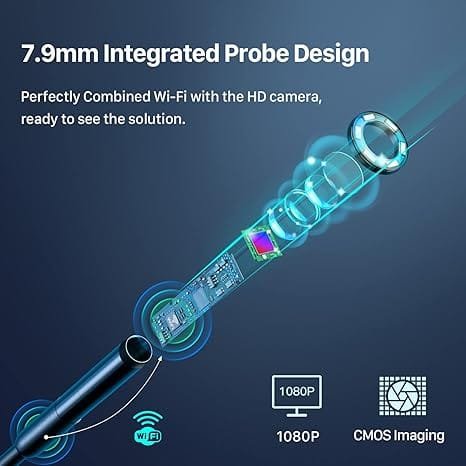
A remarkable feature of the wireless endoscope is its built-in HD camera that allows the user to capture images and record videos in maximum quality. This feature is especially important for tradesmen who depend on accurate visual data to assess a condition or diagnose a situation from a distance. With the HD camera, images can be viewed with better clarity so that you can better recognize issues than with the older inspection tools. With bright LED lights built into the tip of the probe, the endoscope provides you with the best visibility, no matter dim or low-light conditions.
The ability to connect to WiFi has also been integrated into this design, enabling users to share images directly from their device to smartphones or tablets – ideal for sharing an exciting photo straight out of your raft! This feature makes the system easier to operate while also promoting the ability of collaboration as various users can do inspection-data viewing and analysis at the same time. Wireless 7mm mini endoscope camera 5M 10M 3M cable borescope endoscope for Android phone endoscope windows TPU WiFi for iPhone USB The wireless feature takes away the trouble of cords and running the footage and being able to see it in real-time.
In summary, the wireless endoscope with a 7.9mm built-in probe, HD camera and WiFi transmission is a set of inspection devices that take fantastic photographs and shoot high-definition videos for a new experience in inspection. This combination of compactness, rugged construction and high-end features raises the level of usability and portability to a new level, so you’ll want it with you on every job for fast, easy inspections.
Wi-Fi Image Transmission Technology
The WiFi endoscope adopts more advanced WiFi image transmission technology, which can efficiently improve the ability of inspection. The most important feature of this equipment is the excellent transfer rate of 20 frames per second at 2.4 GHz. This fast data transfer is perfect for capturing and viewing real-time images in high definition and during an inspection. The systems further provide the user with a live feed that does not suffer from any of the lag times present with known wired systems, allowing the user to operate based on the most current images available.
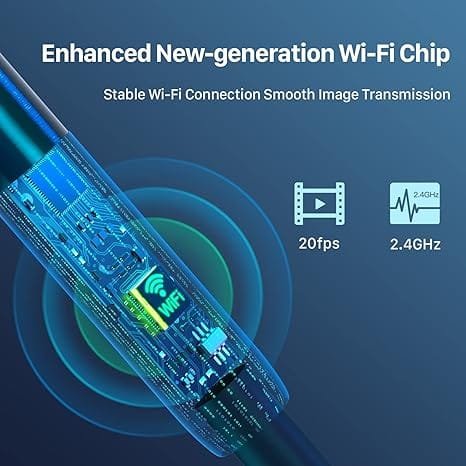
What’s more, by combining WiFi technology with an endoscope, users can be convenient to transfer the images to mobile devices. With a levelling scale and strong accessories, the function of the endoscope matches. With a free downloadable app, people are able to link up with the endoscope’s WiFi network and view everything captured by the device. This easy-to-use style allows the inspection to be done in inaccessible areas without unnecessary cables or monitoring instruments.
The wireless endoscope paired with this app can show live video and also save the photos or videos it offers on Android devices. Users can save these files for review or use later analysis and increase the efficiency of the inspection procedure. Easy to Use: The endoscope feature of the WiFi box allows for real-time viewing, high-resolution image capture and video recording. The convenient wireless design makes the endoscope a useful tool in any inspection applications such as plumbing, automotive and industrial.
Moreover, with the use of 2.4GHZ frequency, the image transfer is unrestricted and quite reliable, and you are less likely to face a jinx, which may cripple your inspection quality. In applications where visibility and detail are critical, these technological steps are a big step forward in inspection efficiency and user confidence. These are the reasons why it is the best wireless endoscope available nowadays in the field of inspection cameras.
High Compatibility with Mobile Devices
In the market, the wireless endoscope is distinguished for its great compatibility with different kinds of smartphones, greatly improving the user experience of this product. This is made possible by the addition of a universal 3-in-1 adapter that contains a Type-C, micro USB and Lightning connector – all fitting into one side of the cable. This feature makes it compatible with the majority of Android and iOS devices, even if they’re made by different manufacturers.
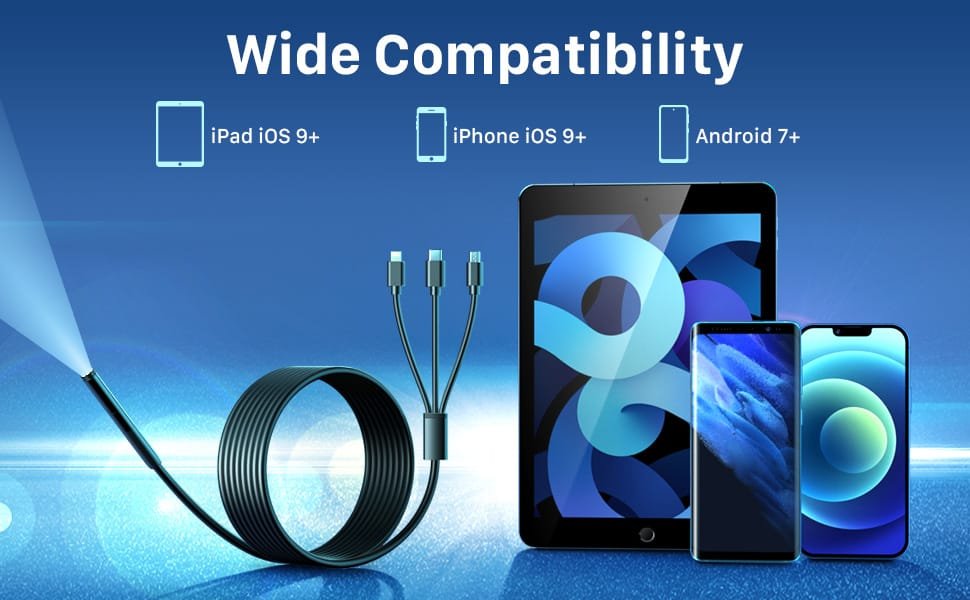
Type-C and micro USB provide a plug-and-play way to connect to your Android device, with no need for any USB driver. For Apple users, however, the Lightning connector is available, so iPhones and iPads can use it. This wide-ranging compatibility is especially useful for personnel who may switch between devices in different work situations (e.g. techs carrying out inspections in diverse locations). The capability of high-resolution images and real-time observation by the use of a cellphone type is an excellent advantage of the wireless endoscope, which basically places it in the category of cheaper but something close to professional endoscopes.
This full integration with mobile technology not only extends its possible use but also brings this device to the bodies of many potential users. Whether it’s for general home use, automotive restoration, precision cutting, or anytime a variety of device connections are required, it can be done with maximum ease of use. Moreover, the use of mobile apps can enable improved image processing and organization to optimize workflow. In the end, this superior compatibility supports the fact that this endoscope is a highly functional instrument for novices and professionals.
IP67 Waterproof Rating
The wireless endoscope is rated IP67 waterproof, so it is dust-tight and resistant to water for up to 1 meter for up to 30 minutes. This rating is an important reference when assessing the durability of the endoscope and its compatibility with different environments of inspection. Being waterproof is a key feature, as many professionals work in an industry where water and dampness are present, and a feature that is going to contend with existing inspection, it will also perform to the required expectations.
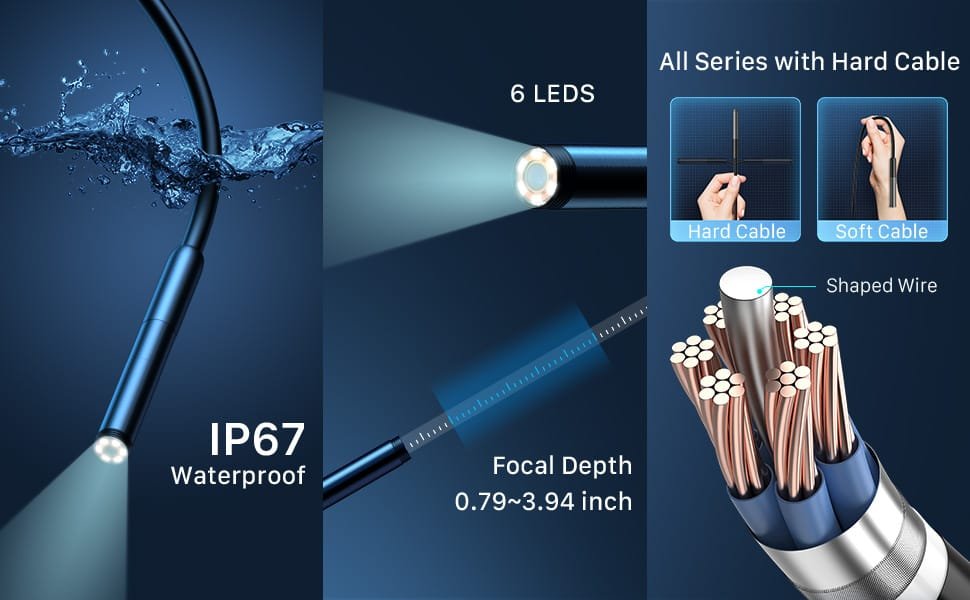
In different cases, the waterproof features of the wireless endoscope make it useful when there is definitely water exposure involved, for example, with clogged pipes or in sinks. That’s not to say that the device lacks durability in fact, it can take more wear and tear than the average device of its kind, and its ruggedness only adds to its versatility and possible applications. Inspectors can now use the endoscope with confidence in the water to conduct tests on underwater elements (e.g. check for leaks or assess for structural soundness) and not damage the scope.
Its IP67 rating means the endoscope will be more dependable and last longer, with less downtime for repairs or replacement. This is especially convenient for inspectors who frequently work in damp or wet locations. A waterproof wireless endoscope will enable peace of mind and long-term value throughout use. In conclusion, the incorporation of such a waterproof rating takes the performance and usability of wireless inspection cameras to a whole new level, and it is an ideal tool for inspecting any type of hard-to-reach place in many different industries.
Ease of Use and Practical Applications
One highly user-friendly instrument that makes it convenient for those in the trade as well as DIY enthusiasts is the wireless endoscope. Installation is quick and simple, and most models include a user manual to walk first-time users through this first-time install. Users usually have to charge the device before it is connected to a smartphone or tablet using an accompanying app. After you are logged in, the use is just as pretty other with all its cool accoutrements to waltz around in is fantastic!
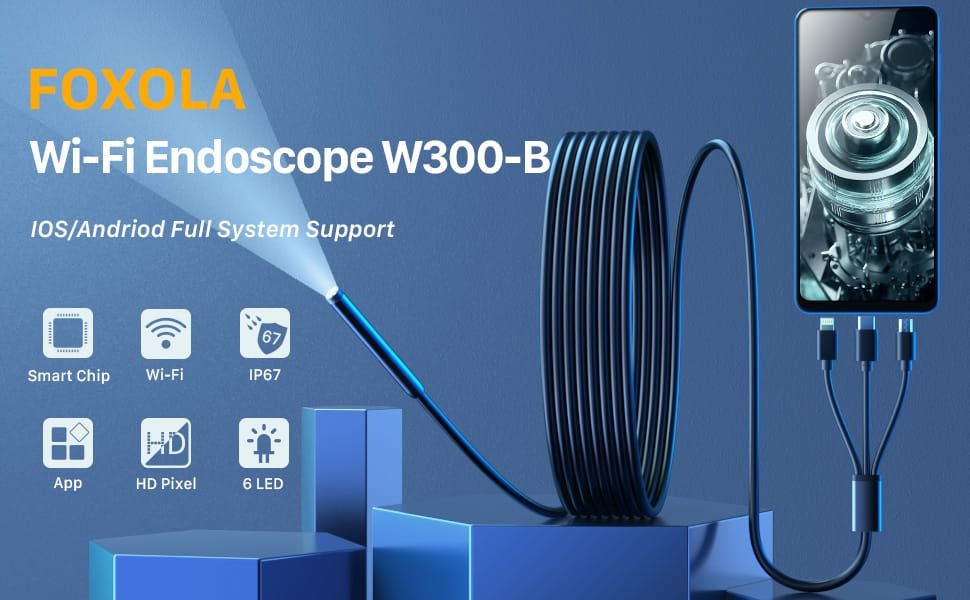
It is easy for any user to control the endoscope. The camera on most models can be quickly and easily activated with a single click of a button, so you can begin inspections right away. It accepts live transmission of high-definition images and videos from the surveillance camera. This capability increases usability by providing users with real-time insight into the inspected area on their smart devices. Additionally, the majority of wireless endoscopes feature flexible LED lights to brighten even the darkest areas to let you enjoy the best visibility during inspections.
Wireless endoscopes have practical applications in many fields. For example, mechanics in the automotive industry can use it to look at the engine and chassis without taking anything apart. This feature doesn’t just help save time; it also reduces possible damage that could be caused by a traditional inspection. In plumbing, too, these types of tools are used for checking clogs or leaks in pipes. Endoscopes make life easier for home inspectors when they are checking inside of walls, in the ceiling or inside attics where it is sometimes not possible to access. The versatility of the device is on the increase, especially as other industries realize its applicability. It may be a perfect tool for inspecting with a professional team, family member, and a neighbour. The wireless endoscope saves much time and makes your job easier.
Performance Review: Image Quality and Stability
The imaging quality and reliability of a wireless endoscope are inherently associated with its performance, and they are of great importance for successful inspection in certain applications. When it comes to image quality, the three main aspects you’re likely to be evaluating are clarity, resolution, and performance in a range of lighting environments. 5th A high-quality image means a fine, precise assessment, and you see problems you didn’t even know were there using lower-quality equipment. The vast majority of present-day wireless endoscopes boast HD or even 4K video, which means that you will be looking at more detailed pictures, which will improve your diagnostic capabilities.

Clarity is key, meaning how well the features can be seen in the image taken. The quality of the lenses plays a major part in this, and so does the technology of sensors. A good lens can work to reduce distortions, leading to a cleaner image. What’s more, the wireless endoscope comes with the latest sensor chip, so the camera has significantly enhanced the image quality, which is much better than any other wireless endoscope camera on the market.
Lighting conditions are also a key factor in the operation of wireless endoscopes. Most products have built-in LED lights that can help illuminate the dark spots – a must for proper inspections. The endoscope can be further practicably advantaged by the fact that, given the brightening variation options, users can easily modify the brightness to match the different demands of inspection of the user. This flexibility is useful, particularly in environments where light intensity levels are changing considerably.
Image stability, on the other hand, is of equal importance. A stable image contributes to an ease of inspection and assists in the accurate identification of the problem. Wireless endoscopes, which feature state-of-the-art stabilization technology, are especially brilliant at preserving the quality of images, regardless of whether the user is on the move or the device is operated through confined areas.
In conclusion, the high-resolution, clear, proper lighting and stable image combination definitely add to the overall picture quality of the wireless endoscopes, which are powerful tools for accurate inspection and assessment.
Pros and Cons of the Wireless Endoscope
Wireless endoscope in professional and personal aspects receives much awareness, so the advantages and disadvantages of it are reviewed. Developing insight into these aspects can enable prospective purchasers to make sound purchase decisions.
The biggest strength of wireless endoscopes definitely lies in their portability. No Need to Plug in Some endoscopes require plugs, but this model is wireless, so you can use it at any time and at any place so you can enjoy total freedom of movement. The small profile is convenient for users to carry and use without neck burden. In addition, many units feature excellent imaging quality, with today’s cameras employing state-of-the-art technology to produce high-resolution images, improving the inspection further.
The wireless aspect also makes it easier to connect since these endoscopes usually hook up to smartphones or tablets using WiFi or Bluetooth. This device allows users to see, record and share what they find in real-time, promoting better communication and collaboration among professionals from different fields. What’s more, without any bulky machinery involved, the risk of a delicate structure becoming damaged during inspection can be extremely useful to both construction and automotive trades.
The wireless endoscope also has its disadvantages. Battery life can be an issue, of course, and depending on the model, and how you use it, a wireless endoscope may spend a considerable amount of time on the charger. This is likely to be inconvenient for online inspection tasks, such as one where instantaneous feedback is paramount. Furthermore, the use of a wireless interface may lead to connection problems, interference, etc., which may degrade the quality of the registered images.
In summary, although the wireless endoscope offers many benefits, such as portability and excellent imaging, potential end-users also need to be aware of its shortcomings of short battery life and the demands of connectivity before making their decision.
Conclusion: Is the Wireless Endoscope Worth It?
Upon using the wireless endoscope in a comprehensive manner, there is no question that the innovative tool can greatly contribute to inspections of different fields. Its wireless capabilities, along with high-definition imaging, are a significant improvement over traditional inspection techniques. The ease of movement in small or limited access spaces, along with the immediate availability of digital imagery, makes a wireless endoscope an essential tool for everyone, from general tradesmen to mechanics. The portability and ease of use are certain pluses you won’t find elsewhere.
Moreover, since wireless endoscopes can be purchased at a relatively low price, a wider population can use this advanced tool as professionals and as well as DIY lovers. The users will save effort, time and highly labour-intensive work when inspected manually. However, prospective buyers will want to consider their individual requirements before making a decision. The performance of wireless endoscopes varies widely depending on the working conditions and on the usage sites.
Another important point to consider to help figure out if a WiFi endoscope is worth it is the quality of the endoscope. With so many different brands and models out there, potential buyers should do some research and read actual user reviews to find a product they can trust and that meets their needs. Consider whether you need long battery life, high image resolution, or compatibility with a computer or mobile device.
Finally, the wireless endoscope has several advantages, and it can help for better inspection and decision. By accounting for specific personal needs and by going through some research regarding amazing models available, users can know for sure if this multipurpose device is really a must-have in their toolbox.
FAQ: Wireless Endoscope
What is a wireless endoscope?
A wireless endoscope is a tool designed to be carried anywhere and operated by users for visual inspection of the most unreachable places available under sufficient lighting. It communicates with mobile devices through WiFi or Bluetooth, which allows live feed viewing and the capture of images and video inspection data.
Is the wireless endoscope waterproof?
Yes, the majority of the wireless endoscopes are waterproof and rated as IP67. They can be placed underwater at 1 meter deep for 30 minutes. This makes them perfect for plumbing and other wet areas.
What do wireless endoscopes work with?
Most wireless endoscopes don’t have issues with Android or iOS devices. The smoking-cessation market is one key area; some such devices offer a 3-in-1 adapter that enables consumers to pair with smartphones, tablets, and sometimes PCs.
How long does the battery life of these electric mowers last?
Battery life depends on the model and usually runs between 1.5 to 4 hours on a charge. You’ll need to consult the specs for the exact duration and charge time.
How do I save the images and videos I’ve recorded?
With the provided app, you can store all the image and video content directly on the attached device in most wireless endoscopes. These files



